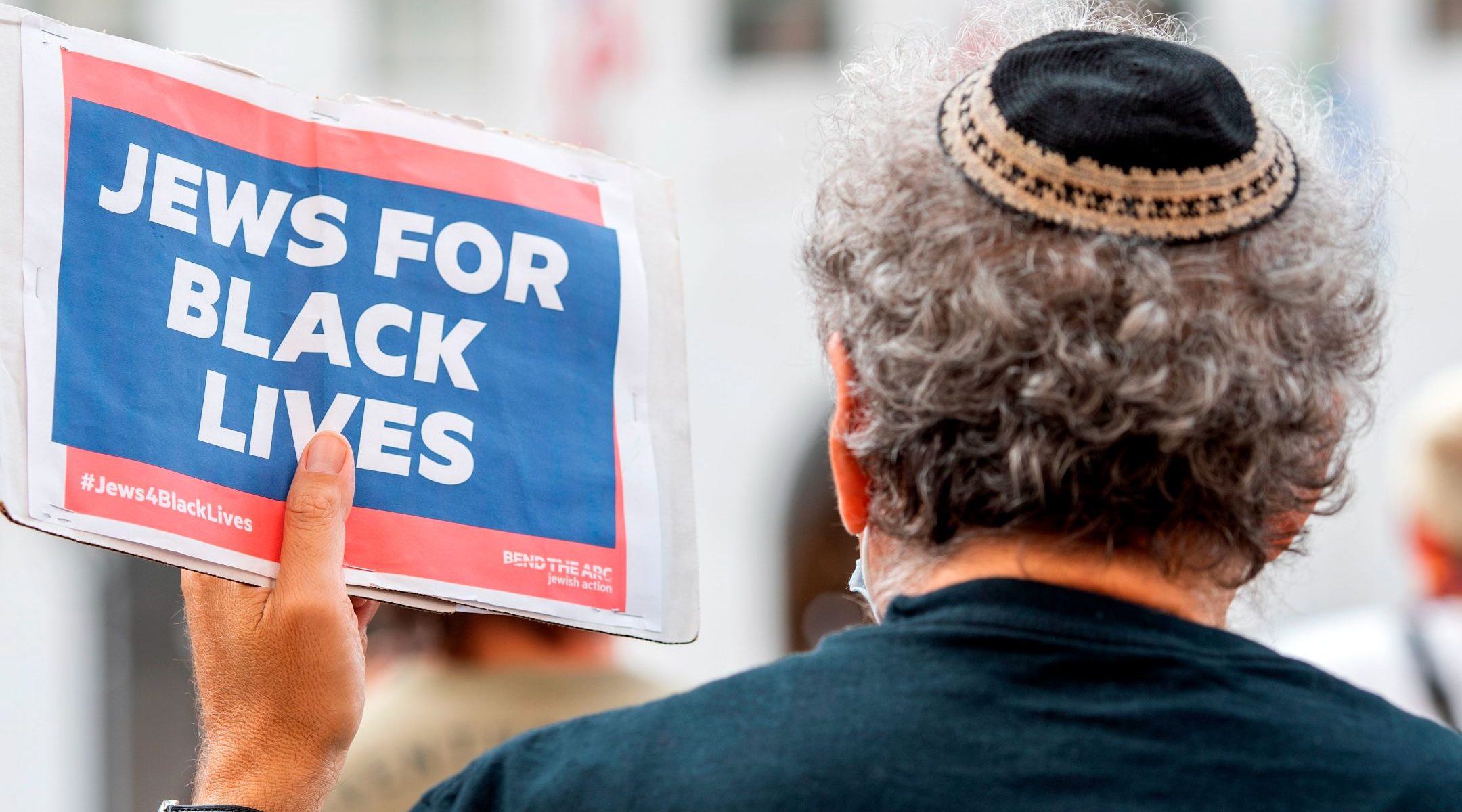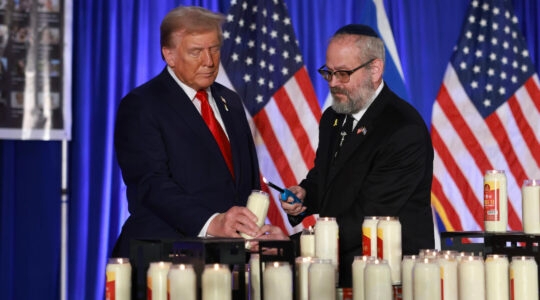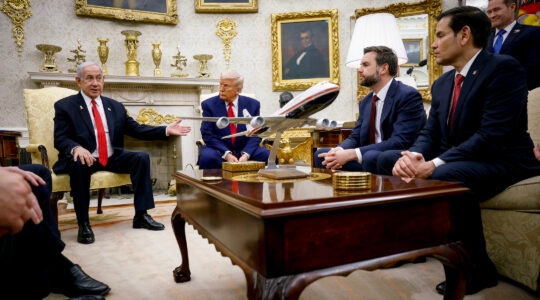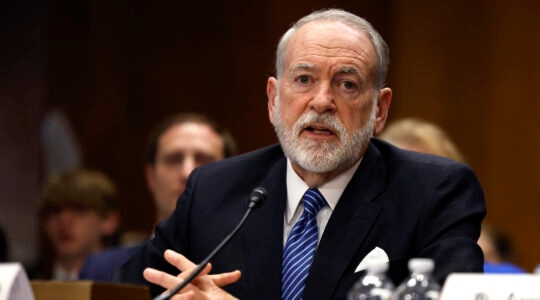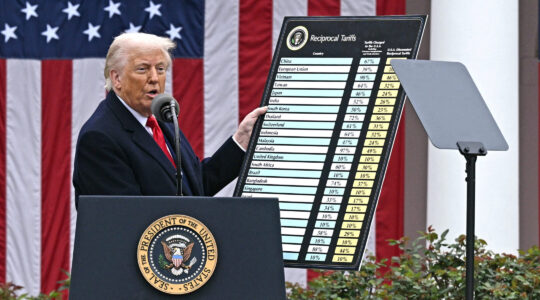(JTA) — The organization that pioneered the Jewish civil rights alliance with Black Americans may lose its independence in part, insiders say, because of its support for the Black Lives Matter movement.
The Jewish Council for Public Affairs, the grassroots-driven community relations network, is in talks about its future with the Jewish Federations of North America, the umbrella body for the federations network.
Neither the JCPA nor Jewish Federations would comment for this story, but some insiders say the likely outcome is the incorporation of the JCPA into the federations umbrella. Such a move would end JCPA’s 75-year history of consensus-driven civil rights advocacy and leave standing a single voice that is deeply beholden to wealthy donors to speak on behalf of Jews on national issues.
Other insiders say the talks are still open-ended and there’s no clear outcome in sight. They emphasize that the “talks” are an exploration and not a negotiation.
They are being led by Eric Fingerhut, the Jewish Federations CEO, and David Bohm, JCPA’s lay chairman. It’s not clear if there is any deadline for a resolution.
Conditions in U.S. politics and the funding and leadership situations of the two groups make a potential merger seem practical on many levels. But the possibility of one has startled some stalwarts of the JCPA, who see it as one of the few remaining places in the Jewish community where unity is cultivated. They also fear its disappearance would bring to an end the leading role that Jewish communities have played in shaping post-World War II America.
The JCPA “represents the most democratic with a small ‘d’ method of coming to policy decisions” as a community, said Hannah Rosenthal, who for years was its executive director and subsequently served as president and CEO at one of its constituents, the Milwaukee federation.
By contrast, the federation system, which raises money for Israel and local Jewish activities, is guided more by donors than by the grassroots, Rosenthal said. Wary of alienating big givers, a combined organization would likely be less inclined than the JCPA to tackle the sometimes controversial issues of racial justice, climate change and stem cell research, she said.
“I’m not telling a secret here, but larger donors have more say over a local community in the federation system than the smaller donor,” Rosenthal said.
The Jewish Telegraphic Agency interviewed more than a dozen people for this story, including the directors of local Jewish community relations councils, the backbone of the JCPA network, and former JCPA staffers. Many declined to speak on the record because of the sensitivity of the topic.
Some of the insiders say the trigger for the JFNA’s effort to effectively take over the JCPA came in August, when the JCPA signed an open letter in The New York Times declaring “Black Lives Matter” along with some 600 Jewish organizations. Others say the talks already were underway.
The ad infuriated some federation officials, who thought it was reckless to endorse a movement despised by Republicans and has been accused of anti-Israel politics.
These officials also worried that the ad threw into question JFNA’s hallmark: nonpartisanship. Even though the JCPA and Jewish Federations are separate national groups, local federations and Jewish community relations councils have a symbiotic relationship: Virtually every local federation funds its JCRC to a degree, and all but a dozen JCRCs are fully incorporated into their federation. That leaves the federations’ fundraising vulnerable to disgruntled donors if a community relations council adopts a divisive opinion.
Traditionally the model was meant to achieve the exact opposite and keep fundraising separate from government and community relations, said Shaul Kelner, a Vanderbilt University professor who studies the contemporary American Jewish community. But that model has grown difficult to sustain, he said.
“As the country has become more polarized, so has the Jewish community. That has made the JCPA’s job much harder,” Kelner said.
During the polarizing debate over the Iran nuclear deal in 2015, for example, federations and their JCRCs agonized over whether to support or reject the deal.
Those close to the JCPA say the community needs a national organization adept at forging alliances with other groups and providing a Jewish voice in shaping civil society. Ron Halber, executive director of the JCRC of Greater Washington, said the federations, which are more susceptible to donor pressures, are necessarily less agile.
“An independent JCPA will shield federations from some of the very, very difficult political issues, and divisive issues,” Halber said.
The JCPA was founded as the National Jewish Community Relations Advisory Council in 1944 by groups eager for the community to speak in a single voice about what would become known as the Holocaust. In the late 1940s, the group led advocacy to end discriminatory immigration policies. By 1950 its focus was civil rights, and it joined with the NAACP to found the Leadership Conference on Civil Rights, which helped spearhead desegregation and voting rights activism. (The organization changed its name in 1997.)
The umbrella body was a major force through the 1980s, crafting consensus policies on immigration, civil rights, pro-Israel advocacy in the wake of the 1967 Six-Day War, and through the ’70s and ’80s on Soviet Jewry.
Its process to make formal statements is arduous, involving months of debate and buy-in from national agencies and constituent JCRCs, which currently number 125. It culminates in a lengthy voting process at the annual JCPA conference. The process is meant to assure credible consensus on issues like Israel, civil rights, hate crimes and, more recently, climate change and stem cell research.
It was even useful when there was no consensus to be had: In 2015, JCPA released a noncommittal statement on the Iran nuclear deal. (Polls showed the majority of the American Jewish community supporting the agreement, but also a significant portion against.)
That process, however, is increasingly out of step with America’s polarized politics, which are reflected in a Jewish community divided between a largely liberal majority and a highly vocal and increasingly activist conservative minority.
Donors more often prefer to give to ideologically driven groups, making JCPA’s emphasis on consensus-building less attractive, insiders say. JCPA’s financial disclosures show a decline in donations from nearly $4 million in 2015 to $2.4 million in 2019, the latest year for which data are available.
JCPA’s struggles have not just been financial. It also lost at least one member: The American Jewish Committee last year quietly removed itself from the JCPA’s national roster, which now includes 16 groups. An AJC spokesman did not return a request for comment.
And more recently, the JCPA has been without a CEO: The most recent person to hold the job, David Bernstein, left at the beginning of this year and now leads the Jewish Institute for Liberal Values, which of late has been warning about the dangers of Critical Race Theory, an educational framework that claims that racism is embedded in legal systems and policies.
Jewish Federations, by comparison, has a stable budget and is a financial behemoth that brought in $270 million in 2019, according to tax records. Some $212 million of that money went out in grants to local federations and other Jewish initiatives. It also has a relatively new CEO in Fingerhut, who joined the organization two years ago — bringing with him, insiders say, a conservative approach to public relations. They point to his years as CEO of Hillel International, where he cracked down on controversial messaging, particularly on Israel. That included inhibiting cooperation on campuses between Hillel and J Street U, the liberal Mideast policy group that is often critical of the Israeli government.
A number of directors of independent JCRCs said they were watching the talks with interest, but many noted that the national JCPA had not influenced their agendas for years.
National organizations find it increasingly difficult to find common ground, evidenced in the infighting and dissension that have divided the Conference of Presidents of Major American Jewish Organizations.
One-size-fits-all no longer serves Jewish communities, said Jeremy Burton, the Boston JCRC director.
“The issues and relationships and partnerships, and where to land on those issues in our increasingly fractured partisan, national conversation, is different for Boston than it is for Houston,” he said. JCRC officials in St. Louis, San Francisco and Minnesota had similar takes.
The JCPA’s added value, said Steve Gutow, who directed the JCPA from 2005 to 2015, is in giving voice to the Jewish “street” — the JCRC constituents that include synagogues, Jewish fraternal societies, grassroots activists and veteran groups that engage in broader community activism.
“This was begun in the ‘40s, this idea that there would be some good to having certain issues looked at by a group of people that were tied to the federation in one way or another, but also were probably more involved with what’s going on in the streets of the Jewish community in levels that aren’t just about giving,” he said.
The polarization of the American polity coupled with the financial crisis of 2008 made Jewish community relations a harder sell for fundraisers, insiders said. It made more sense for donors to give to a Jewish group, on the left or the right, that was wholly dedicated to their politics rather than a body like a JCRC or a JCPA that would necessarily embrace policies that they might not prioritize or even oppose. The process accelerated JCRCs being absorbed into local federations.
The civil rights protests that erupted after a police officer murdered George Floyd, an African-American, in Minneapolis in May 2020 exposed these divisions in the Jewish community.
Bend the Arc, a liberal Jewish social justice group, spearheaded the Aug. 28 ad supporting the Black Lives Matter movement. Its language was unequivocal: “The Black Lives Matter movement is the current day Civil Rights movement in this country, and it is our best chance at equity and justice. By supporting this movement, we can build a country that fulfills the promise of freedom, unity, and safety for all of us, no exceptions.”
The national Jewish establishment, however, was wary of the movement ever since the Movement for Black Lives, an activist group that represents some but not all groups under the BLM umbrella, called Israel an apartheid state and accused it of genocide. Since then, a number of BLM movement leaders have been harshly critical of Israel, drawing parallels between the Palestinian struggle and their own.
Jewish groups who engage with Black Lives Matter note that the movement is decentralized, and that individual members and chapters do not necessarily endorse or even care about criticism of Israel. They see the movement as having evolved into a set of ideals related to racial justice rather than a specific agenda.
In its end-of-year report for 2020, JCPA boasted that it was “standing with the Black community to advocate for ending structural racism in the U.S.” At the same time, it acknowledged that there had been “questions and concerns about antisemitism within the Black Lives Matter movement,” and said it had produced webinars and resources addressing those complaints.
An insider faulted the JCPA for a recent set of resolutions embracing voting rights reforms that are endorsed only by Democrats, as opposed to advocacy for a less objectionable course of action like joining nonpartisan get-out-the-vote drives. But voting rights activists, alarmed by a battery of new laws advanced by Republicans at the state level that would restrict access, see little use for ostensible neutrality.
Fingerhut, representing the federation movement in the discussions with JCPA, is said to be leveraging the fact that the vast majority of constituent JCRCs are wholly federation-run, as well as his influence over the donors. Fingerhut’s critics say he has a tendency to crowd out dissent. His defenders say his leadership style comes with a track record of getting things done.
At Hillel, Fingerhut doubled funding and set clear parameters on Israel policy. And as JFNA’s head during the pandemic, Fingerhut helped wrangle from Congress and the Trump administration massive relief for nonprofits. Fingerhut, who in the 1990s served a term representing Ohio as a moderate Democrat in Congress, is a stickler for nonpartisanship.
The JCPA still endeavors to find common ground. Its most recent resolutions included an urging to advocate for the Muslim Uyghurs under siege in China and to advance the recent normalization agreements between Israel and its Arab neighbors.
Halber said the JCPA is a platform for networking. Some of the Washington JCRC’s best recent initiatives, he said, had come out of talking with other JCRCs. A peer-to-peer program that sends Jewish students to public and private schools to talk about their lives as Jewish teens was modeled in St. Louis. Another that reviews public school curricula on Israel, Judaism and the Holocaust was modeled in San Francisco.
That kind of schmoozing would continue at least informally, but it wouldn’t be the same as “a forum where they can exchange ideas,” Halber said, particularly in a time of crisis.
“With polarization, with the Jewish community in a society where there is the undermining of democratic norms, with the need to bring people together, with the need for Israel advocacy, more than ever with the need for intergroup relations with the rise of antisemitism, this should be the golden age of the JCRC movement,” he said.
Rosenthal, the former JCPA executive director, said the best protection against antisemitism are the alliances forged through the responsive community relations that federations are less able to handle. She recalled as director of the Milwaukee federation convening an interfaith event at a synagogue after the 2018 massacre of 11 Jewish worshippers in Pittsburgh.
“We called upon the faith leaders of other faiths to come up on the bimah, and they came and they kept coming and they kept coming,” she said. “And I started crying, and I’m the child of a [Holocaust] survivor, and I’m looking at all these people who came up to say we stand in solidarity with you, we have your back. And that could not have happened without a robust community relations strategy.”
Steve Windmueller, a professor of Jewish communal studies at Hebrew Union College-Jewish Institute of Religion who has directed the federation in Albany, New York, and the JCRC in Los Angeles, said past crises, including the Six-Day War and the civil rights movement, were moments where a single Jewish voice proved effective. Such moments will continue in the future, he said.
“The community has to figure out how to effectively message what our interests are, especially at a time when we see so much antisemitism and the isolation of the Jewish community from the larger public,” Windmueller said.
JTA has documented Jewish history in real-time for over a century. Keep our journalism strong by joining us in supporting independent, award-winning reporting.
